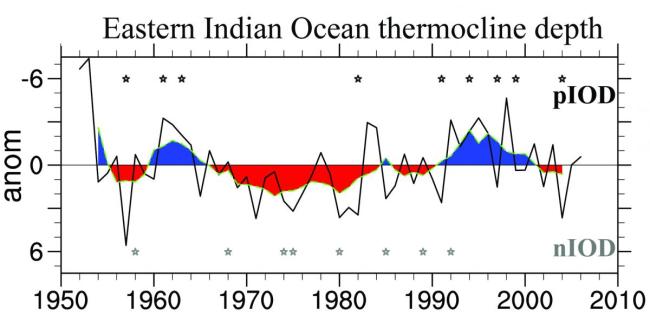Multidecadal Indian Ocean variability linked to the Pacific
Indian Ocean temperatures have exhibited strong warming trends since the 1950s, limited to the surface and south of 30°S, while extensive subsurface cooling occurred over much of the tropical Indian Ocean.

In a new paper from Journal of Climate, researchers show that changes in the Indian Ocean subsurface heat content over the last 50 years can be linked to Pacific Ocean variability associated with the Pacific Decadal Oscillation/Interdecadal Pacific Oscillation. These variations in Indian Ocean heat content are thus a response to Pacific wind forcing.
Transmission of the multidecadal signal occurs via an oceanic pathway through the Indonesian Throughflow. It manifests as westward-propagating Rossby waves across the Indian Ocean, centered along 12°S, and modulates subsurface heat content. These subsurface temperature variations are also reflected as multidecadal changes in the background state of the thermocline in the Indian Ocean. This has implications for the leading mode of Indian Ocean variability, namely the Indian Ocean Dipole. More specifically, positive Indian Ocean Dipole events were unusually common in the 1960s and 1990s with a relatively shallow thermocline. In contrast, the deeper thermocline depth in the 1970s and 1980s was associated with frequent negative and rare positive Indian Ocean Dipole events.
Changes in Pacific wind forcing during recent decades and associated rapid increases in Indian Ocean subsurface heat content can therefore affect the basin’s leading mode of variability. This has implications for decadal climate predictions in the region, where the mostly agrarian societies in surrounding countries are particularly vulnerable to changes in rainfall and droughts.
Multi-decadal Indian Ocean variability linked to the Pacific and implications for preconditioning Indian Ocean Dipole events (Journal of Climate)
1Woods Hole Oceanographic Institution
2GEOMAR, Germany
Topics
- Pacific Ocean
- Modeling
- Indian Ocean
